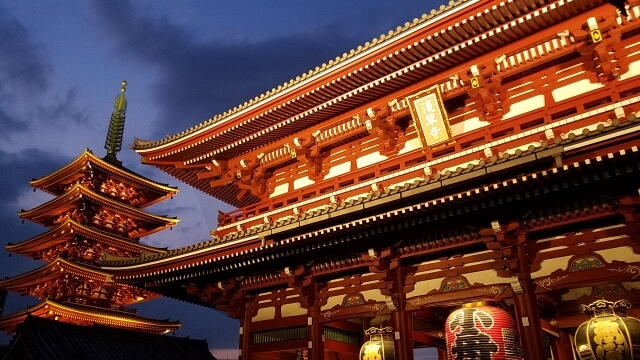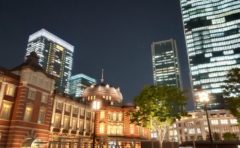Asakusa is the oldest temple in Tokyo, and it is a tourist destination that represents Asakusa. It is famous as a temple with Kaminarimon and many tourists visit throughout the year. Locals are popular as Mr. Kannon of Asakusa, a temple where various events are held, including Hokki city.
We will introduce the charm and attractions of Asakusaji (Asakusa Kannon).
Attraction of Sensoji Temple
Sensoji Temple has been collecting people’s faith for over a thousand years. In this section let’s introduce the charm of such a temple.
Facilities dotted in wide precincts
Sensoji Temple has many famous facilities in Japan and abroad including Kaminarimon and Kannondo. Because there are many places frequently introduced in guide books and television, it is fun to take time to visit these spots.
There is a regular incense burner (Joukouro) in what you can see at a glance the large number of worshipers visiting Asakusa Temple. This is a large incense incense stand between Hondo and Takarazumon. The incense incense was made before visiting the Kannon, the name of the regular incense burner was given because there are many worshipers and the incense stick smoke will not be interrupted. There is also a legend that you can become healthy if you take this incense smoke.
Events to be held at Sensoji temple
In Sensoji Temple, various events are held throughout the year. Among them, the events whose names are nationwide are Shiman-rokusennichi and Sanja festivals. Shiman-rokusennichi is an event to be held on 9th and 10th July every year. It is said that the same meritorious effect as keeping worshipers Kannon for 46 thousand days can be accumulated if you take a day on this day. As cheeks are sold at the approaching shrine, there is another alias called Houzuki Festival, which is a ceremony hosting worshipers in the morning.
The Sanja Festival is now a festival of Asakusa Shrine, but in the past it was a festival that was held jointly with Sensoji Temple. In recent years the Shinto shrine and the Asakusa Shrine jointly done are revived, and the Sensoji Temple is very exciting day on the festival day.
Many shops lining up on the approach
The road from Kaminarimon in Sensoji Temple to Hozomon is called Nakamise-Dori, and there are lots of shops. Many shops dealing with souvenirs and pretty Japanese goods, including thunderstorms of specialties, can be enjoyed just by watching.
There are stores that sell tempura buns and rice cracker in a style that can eat and eat, and there are also many people who enjoy eating in Nakamise after the visit ends.
Have a wide precinct Highlights of Sensoji temple
The wide precincts of Sensoji Temple are dotted with various sights. In this section let’s introduce the features and attractions.
Kaminari gate, widely known both in Japan and abroad
Kaminarimon is the entrance of Sensoji Temple, and this name is attached because the statues of the wind god and the thunder god are enshrined. The current Kaminarimon was built by the donation of Mr. Konosuke Matsushita, the founder of Matsushita Electric.
It is characterized by a large lantern hanging in the center of the gate, and is always crowded with a large number of tourists as a symbol of Asakusa.
Hozomon to place treasure on the tower
Hozomon is a gate located approximately half way between the main hall and Kaminarimon. It is a gate of 2 layers (2 stories), so it is named Hozomon because Treasure is put on the tower. On the left and right of the gate is the statue of Nio enshrined.
Lanterns and hanging lanterns are suspended from the gate, and it is a large straward dedicated to demurrage to draw eye-catching attention. This large straw is regularly donated by the Volunteer association of Murayama City, Yamagata Prefecture.
Pagoda 5 stories
The five-storied pagoda is a pagoda that pays Buddha’s shrine (remains). The five-storied pagoda of Asakusaji was erected in 934 by Tairano-kinmasa. Although it is destroyed many times afterwards, it is rebuilt each time, and in the early Edo period the new five – story pagoda has been rebuilt by the 3rd general Shogun Tokugawa Iemitsu ‘s life. This five-storied pagoda remained until it was destroyed by the Tokyo air raid in 1945, and it was designated as a national treasure.
The current five-storied pagoda was reconstructed by the faithful contributions of the faithful, it is a new-style tower with a pillar, a school office and other attached facilities.
A watering house dedicated to the statue of Dragon
A water shop is about a water shower. The Asakusa Temple is built by donation of the grass cooking and drinking industry association in 1964 (Showa 39). It is built with a windy roof, and the ceiling is drawn with a dragon of Ink painting brush painted brush.
The water bowl from which the water flows out is an octagon, it is a structure that the water flows out from the mouth of the dragon. The statue of Dragon, enshrined above the hand bowl, was built by Koun Takamura, which was once placed in the fountain behind the main hall.
Main hall called also Kannondo
Seven Buddha statues are enshrined in the main temple of Sensoji Temple, including the main image of the Buddhist image of the Buddhist image. There is an alias called Kannondo because it is a monument where the Kannon Bodhisattva statue is rested, and this name is famous. The main honor of Sensoji Temple is a secret Buddha and can not usually be seen. Instead, Honjyoshi’s Omotoi Honjyo who was a third generation priest of Hiei-zan is placed in front of the Imperial Palace which paid the Honzon.
In the main hall, different ceiling paintings are drawn in the outer court who worships the inner buddha where the Buddha statue is resting, and this is also one of the highlights.
A Yogo-do where you can get a Goshuin
The current shadyou (gorodou) was established in 1996 to commemorate the birth of 1200 years, the high priest who established Sensoji Temple as a temple. Inside, in addition to the Holy Bodhisattva Bodhisattva, Kadomoto Shrine of each zodiac enshrines eight bodies and one of the Asakusa sightseeing seven lucky gods, Daikokuten.
The Asakusa Temple of the Asakusa Temple is awarded here, and a lot of people visit the shrine at all times. There are scattered stone Buddhas and stone bridges etc. built around Megumi period from the Muromachi period to the early Edo period.
Awashimado where needle hunting is done
Awashimodo was erected in the early Edo period by the spirit of the woman ‘s guardian god of Kazuta Awashima from Wakayama city Wakayama city. The current Temple of Shrimpo is remodeled by rebuilding the former shadyou (gyuudou godo), and Amitabha Nyorai, Awashima Akashi, and the Virgin Bodhisattva statue are enshrined. It is also famous for having a needle dressing on February 8 every year.
Sensoji Temple recommended event
In Asakusa Temple, various events are held throughout the year. In this section, let’s introduce a press event.
Hozuki-ichi (Shiman-rokusennichi)
On July 9th and 10th every year, Hozuki-ichi is open on the approach road to match the Shiman-rokusennichi of Sensoji Temple. Originally Hozuki-ichi was an event at Atago Shrine, but it came to be carried out at Sensoji temple once. In the middle of the Edo period it is said that the crowning city of Asakusa Temple was more popular.
Hozuki were once handy as medicinal herbs. Currently, ornamental potted plants are mainly sold. Besides this, for 2 days it was specially awarded a lightning-free bill at the temple, which is popular among worshipers.
Sensoji Jimai
Sensoji Jimai started dedicated to commemorate the reconstruction of facilities of Sensoji temple, including the main hall and Kaminarimon in the Showa 30 ‘s. It is dedicated to the temple events held in February, March, April, May and October, and there are dance of gold dragons and dance of Shirasagi. Among them, Shirasagi ‘s dance to be dedicated at the Sanja Festival is famous.
Summary of Sensoji Temple
We introduced the highlights and charm of Sensoji Temple.
Many people from overseas as well as from Japan visit the shrine at the current Sensoji Temple. If you want to see the facilities slowly even a little, we recommend early in the morning. Facilities at Sensoji Temple will be opened at 6 AM. People are sparse as long as Nakamise is open.
The day of the fair being held at the facility is particularly crowded, so if you check the dates in advance, you can avoid congestion.









